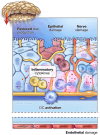The Role of Immune Cells and Signaling Pathways in Diabetic Eye Disease: A Comprehensive Review
- PMID: 39457658
- PMCID: PMC11505591
- DOI: 10.3390/biomedicines12102346
The Role of Immune Cells and Signaling Pathways in Diabetic Eye Disease: A Comprehensive Review
Abstract
Diabetic eye disease (DED) encompasses a range of ocular complications arising from diabetes mellitus, including diabetic retinopathy, diabetic macular edema, diabetic keratopathy, diabetic cataract, and glaucoma. These conditions are leading causes of visual impairments and blindness, especially among working-age adults. Despite advancements in our understanding of DED, its underlying pathophysiological mechanisms remain incompletely understood. Chronic hyperglycemia, oxidative stress, inflammation, and neurodegeneration play central roles in the development and progression of DED, with immune-mediated processes increasingly recognized as key contributors. This review provides a comprehensive examination of the complex interactions between immune cells, inflammatory mediators, and signaling pathways implicated in the pathogenesis of DED. By delving in current research, this review aims to identify potential therapeutic targets, suggesting directions of research for future studies to address the immunopathological aspects of DED.
Keywords: diabetes; diabetic eye disease; diabetic keratopathy; diabetic retinopathy; immune cells; inflammation; pathophysiology; signaling pathways.
Conflict of interest statement
The authors declare no conflicts of interest related to this study.
Figures



References
-
- Sun H., Saeedi P., Karuranga S., Pinkepank M., Ogurtsova K., Duncan B.B., Stein C., Basit A., Chan J.C.N., Mbanya J.C., et al. IDF Diabetes Atlas: Global, Regional and Country-Level Diabetes Prevalence Estimates for 2021 and Projections for 2045. Diabetes Res. Clin. Pract. 2022;183:109119. doi: 10.1016/j.diabres.2021.109119. - DOI - PMC - PubMed
-
- Bourne R.R.A., Jonas J.B., Bron A.M., Cicinelli M.V., Das A., Flaxman S.R., Friedman D.S., Keeffe J.E., Kempen J.H., Leasher J., et al. Prevalence and Causes of Vision Loss in High-Income Countries and in Eastern and Central Europe in 2015: Magnitude, Temporal Trends and Projections. Br. J. Ophthalmol. 2018;102:575–585. doi: 10.1136/bjophthalmol-2017-311258. - DOI - PMC - PubMed
Publication types
LinkOut - more resources
Full Text Sources

